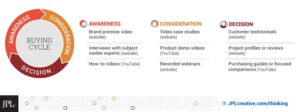Video is a powerful way to engage informed and research-savvy decision makers. However, many marketers still employ an outdated approach to video. For example, a traditional “company overview” video may be forced to carry the burden of proof. What that single video needs to accomplish is too great and it reduces visibility of your message. Rather than leave too much to chance, incorporate different types of video across the buying cycle.
When used correctly, video will convey your brand story strategically over time. Your prominence in search-related inquiries will increase as your story becomes validated across multiple touch points.
Here are two steps you can take to begin incorporating more video across the buying cycle:
Step 1: Map your buying cycle to pinpoint where video makes sense.
- Make a chart of your industry’s buying cycle
- List what types of content are relevant to each stage
- From those topics, define what content types would make great videocontent
Here is an example of a well-balanced buying cycle chart to get you started in the right direction. Once you have identified your video “wish list,” identify where buyers will be looking for this type of information to inform how you distribute it.
Step 2: Work with your production partner to develop a program that maximizes the video production budget.
- Review your existing video and photography assets, content calendar and buying cycle chart with your partner. Discuss the objectives of your content program and how you want to measure video performance upfront. Highlight the calls to action that will be guiding prospects to the next stage.
- Talk about planning for quality, quantity and consistency. Things like templates for video case studies, a brand graphics package, asset quality guidelines and script outlines are tricks of the trade you need to take advantage of to get your video content program off the ground. These tools create strong collaboration and project efficiency. They also build consistency in brand voice.
- Discuss how to bring your story to life using motion graphics and animation. They can fill gaps in your asset library, expand your video distribution possibilities and help to explain complex topics or processes.
In the race to develop video content, remember to have a strategy in place that is mapped to your buying cycle and includes your production partner’s expertise. Ultimately, these steps will keep you on course and progressing toward your goals for the long term win. Your video content will reflect quality, come together faster and require less budget with these steps in practice.
Jessica Melhorn is the director of client solutions at JPL.




